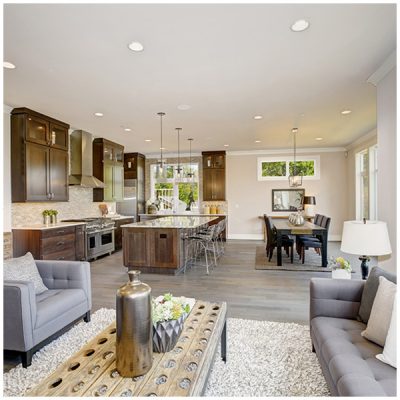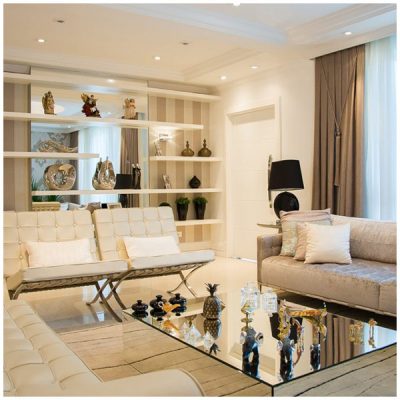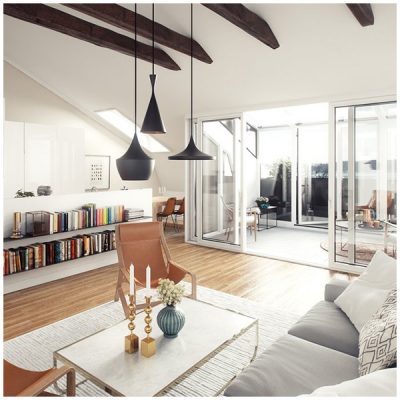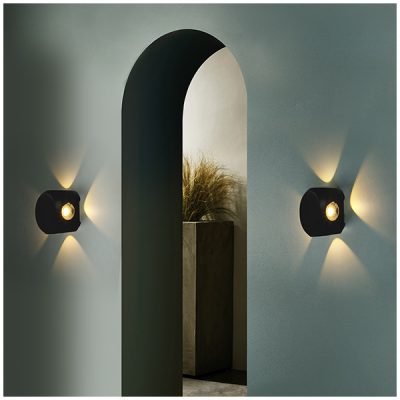
“Without lights, we would not know our own world”
The design world is empty without lighting. It is through lights that physical space is aesthetically defined, enhanced & perceived. Lights signify the value of space and consistently support the abstract and objective existence of the room. The most suggested and preferred lights for indoor lighting are interior led lights for homes. LED lights are energy-efficient & durable. The lights do not emit any toxic radiation and can be, without any worries, used in closed personal spaces for long hours.

Contents
- 1 1. Optimal Color Management
- 2 Use of LED Track Lights
- 3 Statement Lights
- 4 Geometric Lighting Patterns
- 4.1 How Light Can Help You?
- 4.2 Buy Lighting In Home’s Interior Designing
- 4.3 The Importance of Lighting in Home’s Interior Designing Strategy
- 4.4 1. Creates Mood and Ambiance
- 4.5 2. Enhances the Visual Appeal of the Space
- 4.6 3. Increases Functionality and Practicality
- 4.7 4. Defines Space and Zones
- 4.8 5. Enhances the Room’s Size and Perception
- 4.9 6. Showcases Color and Texture
- 4.10 7. Adds Energy Efficiency
- 4.11 8. Creates a Welcoming Atmosphere
- 4.12 9. Impacts Health and Well-being
- 4.13 10. Personalizes Your Space
- 4.14 Conclusion:
How LED Indoor Lighting Plays A Crucial Role In Home Renovation?
1. Optimal Color Management
We all know that it is our sense of vision that helps us see the beauty of the world. Proper lights are a delightful complement to vision. Strategically led lights ensure optimal color management. Every room has a theme of its own and a unique color palette. Lights help in adding/subtracting the color-play of the rooms. Like, the dark theme of a room leads to the perception of smaller spaces. White is usually preferred as it tricks into perceiving larger rooms and uncluttered themes. There are many different lighting styles that can aid in extensive color management. More on this is discussed below in the “Lighting Ideas” section.
2. Aid To Our Working Activities
The prime purpose of LED indoor lighting is to effectively help us in our regular activities, from playing to working to meeting others. The evolution of lighting technology is on the premises of supporting people & adding elegance. The role of lighting in interior design, in these terms, is to stick to its purpose while smoothing the flow of transition between different activities.
A smart place is one that can accommodate different working themes, such as reading, studying, watching TV, etc. For such purposes, a mix of different lighting fixtures is available for indoor lighting. If you buy led lights online, you will find a variety of options for brightening, let’s say, just your side-table. Likewise, there are many options for every element of a room.
3. Uplifting The Value Of A Space
A dim-lit room or an ill-lit room is an unpleasant sight and loses its functional value. Lighting plays a crucial role in illuminating a space, especially during the nocturnal hours. You can use LED lights for longer hours and define the physical space. Another bonus is ensuring safety. A well-lit room is a secure room, pushing away the steps of darkness.
Lumination is necessary for the body’s natural clock to follow the day’s timeline as well. LED lights aid in ambient lighting, which ensures that the room is uniformly well-lit and ready to be equipped for the day.

4. Playing With The Illusion Of Space
There is limited land, and limited physical space, but there is no limitation on the use of perceptual tricks & illusory correlations to enhance the look of a place. With strategic LED indoor lighting (use of hanging lights, spotlights), interior designers can create the illusion of a bigger space. Recessed lighting can boost the style of any place with minimal investment and altercation. Recessed led lights are available in many forms and shapes, and these can even be used on surface areas.

5. Indoor Lighting & The Psychology of Human Beings
Lighting has quite an effect on the psychology of people. It influences perception, mood, motivation, optimism, and much more. Within the realms of interior design, it becomes crucial to use lighting for the advantage of the resident. Interior designers use different types of lights, different color temperatures, and a variety of lighting fixtures to set a particular mood, boost motivation, and more.
LED Indoor Lighting is the solution to a wide range of things. Within the domain of interior lighting options, mood lighting is progressing and being used commonly these days. Mood lighting is a tried-and-tested way to improve relationships, direct communications and boost the overall mood of the people in the room. A slight shift from the white light to the warm light can smoothen the tone of your conversations. Many leading LED lights manufacturers sell multiple-lighting bulbs, like a 3-in-1 light bulb. These are multi-purpose and efficient.
What are some primary mind-influencing indoor lighting ideas?
- Bright lights intensify the emotions, be it positive emotions or the negative ones
- LED lights with a blue tint (shorter wavelength) produce a calming effect in the environment
- Indoor LED lights with red tint (longer wavelength) are noted to be conducive to better sleeping
- Extreme brightness at the nocturnal hours can create abnormality in the sleep cycle
- A combination of day-light and bright artificial indoor lighting can significantly boost productivity
Latest Indoor Lighting Ideas For A Dynamic Home Interior
Use of LED Track Lights
Track lighting is a great way to pave out the direction for yourself and your visitors. The soft light of track lights oozes luxury and subconsciously, reduces mindless thinking. Mostly track lighting follows a linear pattern. It can be used to guide, lay focus on corners, or merely define walls. Interior designers choose to play with positions of track lighting to optimize vision and perception. Nowadays, there are different colors and multi-color track lights available, you can select as per your needs.
Statement Lights
The latest trend of 2021 in indoor lighting is statement lights. Statement lights are nothing but big lights as the focal points of a room. Most living rooms have a chandelier or a cluster of such lights – this trend is now expanding to other rooms as well. Many people prefer large pendant fixtures in the kitchen. In places like the washroom, large hanging spotlights are chosen. The purpose behind this is the ideology of making a statement in the most minimal ways. They are not just a way of lighting but also an accessory to the particular room.

Geometric Lighting Patterns
Humans have always been attracted to patterns and symmetry. Geometric indoor lighting is a style of structuring led lights. The most famous among indoor lighting ideas is the placement of two identical wall sconces. Wall sconces are graceful lighting fixtures that add themselves as an element of home decor. There are options for two-way/three-way light fixtures as well. These lighting options create an illusion of a linear-contrasting pattern on the walls.
Alongside these three popular trends, people are opting for task lights and spotlights as prime indoor lighting options. There is quite an emphasis on accent lighting alternatives. All these indoor lights ideas can be executed through LED lights. LED lights are, primarily, the foremost choice for interior lighting and decor, as these are also safe to use for long hours.

How Light Can Help You?
Light has a vast collection of indoor led lights. Their range of products is diverse, flexible, and modern. Light’s research team emphasizes energy-efficient technology that keeps both your pocket and the environment happy. The products of Light are made from the best raw materials, with sturdy exteriors and steady durability. Our products can be seen in-action across different places, from gyms to saloons.
The team of Light supports you throughout the journey. Our prime client, Delhi’s famous make-up artist Leena Bhushan’s new studio is brightened by our team. We curate modern and customized indoor lighting layouts, catering to all your artistic desires. We provide consultation services, installation support, and after-sales help as well.
Buy Lighting In Home’s Interior Designing
The Importance of Lighting in Home’s Interior Designing Strategy
Lighting is one of the most powerful elements in interior design. It has the ability to transform a space, create ambiance, highlight specific features, and improve functionality. Whether you’re designing a cozy living room, a modern kitchen, or a serene bedroom, lighting plays a critical role in bringing everything together. Let’s explore why lighting is so essential in a home’s interior design and how it can elevate your living spaces.
1. Creates Mood and Ambiance
The mood of a room can be greatly influenced by the type and quality of lighting used. Whether you want a warm, cozy atmosphere or a bright, energizing environment, lighting helps set the tone for the entire space. Different lighting intensities and colors (also known as color temperature) can create a range of moods:
-
Warm Lighting (2700K-3000K): Ideal for creating a relaxed, cozy, and inviting atmosphere, perfect for living rooms, bedrooms, and dining areas.
-
Neutral White Lighting (3500K-4100K): Works well in spaces like kitchens or bathrooms, where you need good visibility and a clean, crisp look.
-
Cool White/Daylight Lighting (5000K-6500K): Perfect for workspaces, offices, or areas where focus and concentration are key. It can also be great for highlighting architectural features or creating a modern and sleek feel.
2. Enhances the Visual Appeal of the Space
Lighting helps highlight the design elements of your home. The right placement of light fixtures can emphasize artwork, architectural features, furniture, or even textures. It brings out the best in the room’s design by casting shadows, creating patterns, and accentuating focal points.
-
Accent Lighting: Used to draw attention to specific features such as sculptures, paintings, or architectural details.
-
Task Lighting: Helps with activities that require focus, such as reading, cooking, or working.
-
Ambient Lighting: The general lighting that illuminates the whole space, providing a comfortable level of brightness without causing strain.
3. Increases Functionality and Practicality
Lighting is not only about aesthetics; it’s also about practicality and functionality. Proper lighting ensures that you can perform everyday tasks comfortably and safely. For instance, good lighting in the kitchen or bathroom can make cooking and grooming tasks easier, while desk lamps or overhead lighting in a study area helps you focus on work or study.
-
Task Lighting: Specific lighting to aid activities like reading, cooking, or working.
-
General Ambient Lighting: Provides overall illumination for the room, ensuring there are no dark corners or areas.
4. Defines Space and Zones
In an open-concept space, lighting is key to defining different zones and creating flow. It can help separate dining, living, and kitchen areas, while still maintaining a sense of continuity. For example, a pendant light over the dining table or a set of floor lamps near the seating area can help create visual boundaries without the need for walls.
-
Layered Lighting: Combining ambient, task, and accent lighting can create different zones and add depth to the space.
-
Statement Lights: A statement chandelier or pendant light can also serve as a focal point in larger spaces, adding character to the design.
5. Enhances the Room’s Size and Perception
Lighting can also influence how spacious or cozy a room feels. By adjusting the type and placement of lighting, you can make small rooms appear larger or make large spaces feel more intimate.
-
Light Colors and Brightness: Bright, well-lit spaces appear larger, while darker, more focused lighting can make large spaces feel cozier.
-
Mirror and Light Combo: Reflecting light with mirrors or metallic elements helps bounce light around the room, giving a sense of more space.
6. Showcases Color and Texture
Lighting has a huge impact on how colors and textures are perceived. For instance, warm lighting brings out the richness of wooden tones, earthy textures, and red hues, while cool lighting can enhance cooler tones, white, and blue colors.
-
LED Lights with Color Temperature Adjustments: Modern LED lights allow you to control the color temperature, helping you tailor the lighting to showcase the room’s color palette.
-
Task Lighting: Focused lighting on textures such as stone walls, wooden beams, or fabric patterns can highlight these design elements.
7. Adds Energy Efficiency
Incorporating energy-efficient lighting options such as LED bulbs and smart lights not only enhances the beauty of a room but also reduces your energy consumption. LEDs are long-lasting and use much less power than traditional incandescent bulbs, which helps you save on electricity bills.
-
Smart Lighting: Modern smart lighting systems (like Philips Hue or LIFX bulbs) allow you to control the brightness, color, and timing of the lights through a smartphone app. These systems also help reduce energy consumption by adjusting the lighting based on your needs.
-
Dimmable Lights: Installing dimmable switches allows you to adjust the lighting to suit your mood or task, contributing to energy savings.
8. Creates a Welcoming Atmosphere
The right lighting gives a sense of warmth and invitation. For example, when you come home after a long day, soft lighting in the entryway and living room creates a sense of comfort and relaxation. Overhead lights can sometimes feel too harsh, so using softer, layered lighting options can create a more welcoming vibe.
-
Ambient Lighting: Soft and diffused lighting that adds a comfortable glow to a space.
-
Wall Sconces: These provide subtle, indirect lighting, creating a calm, relaxing atmosphere.
9. Impacts Health and Well-being
Proper lighting can positively impact your mental and physical well-being. Natural light is known to enhance mood, productivity, and overall health. However, if your home doesn’t get much natural light, carefully placed artificial lighting can help compensate for this.
-
Circadian Lighting: Lighting that mimics the natural course of daylight can help regulate your body’s sleep-wake cycle. It’s particularly helpful in home offices or bedrooms.
-
Blue Light Control: Avoid excessive blue light, especially in the evening, to promote better sleep. You can install warm-toned lights to reduce blue light exposure before bed.
10. Personalizes Your Space
Lighting can reflect your style and personality. From modern pendant lights to vintage sconces or quirky floor lamps, the choice of lighting fixtures can enhance the aesthetic of any room. Whether you prefer minimalistic, industrial, or bohemian styles, lighting can complement your taste and create a unique atmosphere in your home.
-
Statement Lighting: Eye-catching chandeliers or pendant lights in the dining room or entryway can make a bold statement and add personality to the space.
-
Decorative Lighting: Use string lights, fairy lights, or neon signs to add character to bedrooms, living rooms, or personal spaces.
Conclusion:
Lighting is far more than just a functional element in interior design; it’s a powerful tool that can transform the mood, emphasize design elements, and enhance the overall atmosphere of your home. By thoughtfully selecting and placing lighting fixtures, you can create a space that feels both beautiful and functional. Whether you’re aiming for a calming ambiance, a productive workspace, or a cozy gathering area, the right lighting will make all the difference in how your home looks and feels.